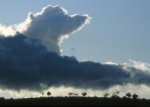Atmospher Sci & Global Chg
Research Highlights
January 2010
Jiwen Fan helps Demystify Pollution's Impact on Storm Clouds
Past studies showed conflicting conclusions, and now we know why

Under certain conditions, pollution can either strengthen or weaken thunderstorm clouds. Researchers solved a mystery on how pollution changes the strength of thunderstorms. Photo courtesy of UCAR/Carlyle Calvin. Enlarge Image
Results: A team of atmospheric scientists led by Dr. Jiwen Fan of the Pacific Northwest National Laboratory recently figured out why seemingly conflicting data showed pollution makes storms stronger in some cases and weaker in other cases. The team designed computer simulations to tease out how aerosols from pollution affect storm development and realized the confusion wasn't with pollution at all. It was with wind shear, a difference in wind speed and/or direction.
Under strong wind shear conditions, pollution hampers thunderhead formation. But with weak wind shear, pollution does the opposite and makes storms stronger; at least, until pollution reaches an optimum.
Fan presented their findings in December at the 2009 American Geophysical Union meeting in San Francisco.
Why it matters: The work improves climate scientists' understanding of how aerosols, or tiny unseen particles that make up pollution, contribute to isolated thunderstorms and the climate cycle. How aerosols and clouds interact is one of the least understood aspects of climate, and this work allows researchers to better model clouds and precipitation in order to predict future climate.
"This finding may provide some guidelines on how man-made aerosols affect the local climate and precipitation, especially for the places where 'afternoon showers' happen frequently and affect the weather system and hydrological cycle," said Fan. "Aerosols in the air change the cloud properties, but the changes vary from case to case. With detailed cloud modeling, we found an important factor regulating how aerosols change storms and precipitation."
The results provide insight into how to incorporate these types of clouds and conditions into computational climate models to improve their accuracy.
Methods: The team ran a computer model with atmospheric data collected in northern Australia and eastern China. They simulated the development of eight deep convective (smaller and more spread out) clouds by varying the concentration of aerosols, wind shear, and humidity. Then they examined updraft speed and precipitation.
In the first simulations, the team found that in scenarios containing strong wind shear, more pollution curbed convection. When wind shear was weak, more pollution produced a stronger storm. But convection also changed depending on humidity, so the team wanted to see which effect—wind shear or humidity—was more important.
The team took a closer look at two cloud-forming scenarios: one that ended up with the strongest enhancement in updraft speed and one with the weakest. For each scenario, they created a humid and a dry condition, as well as a strong and weak wind shear condition. The trend in the different conditions indicated that wind shear had a much greater effect on updraft strength than humidity.
When the team examined the expected rainfall, they found that the pattern of rainfall followed the pattern of updraft speed. That is, with strong wind shear, more pollution led to less rainfall. When wind shear was weak, more pollution created stronger storms and more rain—up to a certain point. Beyond an optimum level, more pollution in the aerosol also led to the decreased convective strength.
Additional analyses described the physics underlying these results. Water condensing onto aerosol particles releases heat, which contributes to convection and increases updraft speed. The evaporation of water from the cloud droplets cools the air, which reduces the updrafts. In strong wind shear conditions, the cooling effect is always larger than the heating effect, leading to a reduction in updraft speed.
What's next: This research considered wind shear from ground level to seven kilometers. One of the next steps is to analyze which levels of wind shear have the strongest effects, those that originate at low levels or those that originate at middle levels? Future research will analyze the observational data from DOE's Atmospheric Radiation Measurement (ARM) Program field campaigns to look at some observational evidence in the real atmosphere.
For more information: Read PNNL's press release announcing this research. A video of Fan discussing the team's findings in Chinese can be viewed here.
Acknowledgments: This research was funded by the PNNL Laboratory Directed Research and Development program in support of the Laboratory's Aerosol Climate Initiative.
Reference: Jiwen Fan, "Dominant Role by Vertical Wind Shear in Regulating Aerosol Effects on Deep Convective Clouds" Dec. 18, 2009. Presentation at 2009 AGU Conference, San Francisco, Calif.
J. Fan, T. Yuan, J. M. Comstock, S. Ghan, A. Khain, L. R. Leung, Z. Li, V. J. Martins, M. Ovchinnikov. 2009. "Dominant role by vertical wind shear in regulating aerosol effects on deep convective clouds," J. Geophys. Res., 114:D22206, doi:10.1029/2009JD012352.

